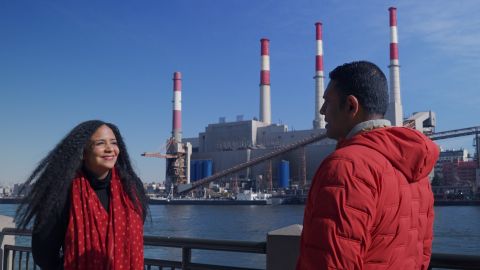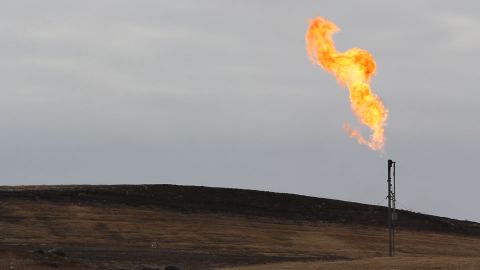Climate Change Is Forcing American Women From Their Homes
By Jena Brooker

The aftermath of a California wildfire. Credit: Peter Thoeny via Flickr
On September 8, 2020, Ashley Diaz and her two small children were asleep in their beds when Diaz heard a knock on the door. It was a neighbor warning them about an approaching wildfire. Diaz, who was seven months pregnant at the time, hesitated at first. She was living in Happy Camp (pop. 844), homeland of the Karuk tribe in northern California, where fires were commonplace.
Twenty minutes later, she got a “bad feeling.” She hurriedly gathered what she could: some children’s clothing and her father’s ashes. As Diaz drove away from her home of 16 years, she saw the flames advancing.
“The house was literally going to be on fire,” she said. “If we had slept in another ten minutes, I’m sure we would not have made it out,” she said.
The Slater Fire tore through the small community, killing two and destroying some 200 homes. In losing her home to wildfire, Diaz and her family joined the growing ranks of Americans displaced by climate-related disasters. In 2020, displacements of people by disaster in the U.S. totalled 1.7 million, according to the Switzerland-based Internal Displacement Monitoring Centre. (The figures reflect the number of displacements and not the number of people affected, as some people are displaced multiple times in a year.) Researchers predict the numbers will grow by a quarter-million each year, as wildfires, storms, floods, heatwaves and droughts become more frequent and intense.
Women bear most of the burden. According to the United Nations, 80 percent of those displaced worldwide by climate change are women and children.
There is limited gender-specific data on climate displacement in the United States. The Federal Emergency Management Agency, FEMA, does not break down its data by gender. But experts say that poverty and caregiving responsibilities, which make women vulnerable to climate change globally, are factors in the U.S. too.
Nearly 13 percent of women in the U.S. live below the poverty line, as compared to 10.6 percent of men. Nationally, 80 percent of single-parent households are headed by women.
“Women are often impacted because they just have fewer resources, due to systemic inequity and injustice,” said Margaux Granat, founding director of EnGen Collaborative, a Washington-based consultancy.
Granat pointed to Hurricane Katrina, in 2005, as an event that showed the disproportionate impact of climate-related disasters on women, particularly women of color. Even before the storm, women were more likely to live in poverty and head up single family households. Afterward, women experienced a spike in gender-based violence, they were more likely to be unemployed, and they had the greatest difficulties in returning to their homes.
Prior to the fire, Diaz, who is 28, was already struggling to make ends meet. She had been laid off from her job as a cashier at a grocery store and was relying on unemployment assistance.
When the fire destroyed Diaz’s home, it also destroyed any stability that she and her children, now five, two and one, had found. In the months following the fire, the family evacuated to a motel, where Diaz gave birth to her youngest son. The family then moved into temporary housing provided by the Karuk tribe, and later into a mobile home, where Diaz performed odd jobs in exchange for free rent. In February 2022, she and her children were evicted.
Now the family is homeless, “going back and forth everywhere,” Diaz said. They stay with her brother for a few nights, then with a friend, rotating so as not to overburden anyone.
“The emotional part – it’s really bad. And then my kids have to deal with it, too. All this stress that I go through,” said Diaz.
None of the places where they’ve stayed has been particularly child-friendly, Diaz said. At the motel, she had to lug strollers and supplies up several flights of stairs. One of the trailers had hot water for only about a minute at a time, making it nearly impossible to bathe the kids. And the town lacks affordable diapers and other basic items, so she has to drive to the next town over for supplies.
Since the Slater Fire, Diaz has struggled to get back on her feet. The fire decimated the local housing stock, so Diaz takes daily trips outside of Happy Camp to look for housing. Coordinating with welfare agents in one town and landlords in another — all while ensuring her children are being looked after — is doubly challenging, Diaz said. She received some money from FEMA, which she spent on rent, gas and other day-to-day needs. Since the fire, she’s been unable to get a job.
Diaz’ experience is hardly unique, said Carlos Martín, a housing expert at the Brookings Institute.
“Households headed by women have that much more of a challenge because you can’t easily apply [for federal assistance] if you’re dealing with your kids, housing issues, health issues, et cetera,” said Martín. Following a disaster and evacuation, people often try to move as close to their original community and support systems as possible. This provides a sense of stability that is particularly important to families with children, as parents often want to avoid changing school systems and daycare routines.
Climate-related disasters threaten already precarious housing situations, said Melissa Villarreal, a researcher at the University of Colorado Boulder. Women are less likely than men to be homeowners, and more likely to be dependent on housing assistance. Women are also more likely to face eviction, a danger that increases in the wake of disaster. Renters’ homes are at higher risk of being destroyed in climate disasters than those of homeowners. Even so, renters rarely receive assistance, Villarreal said.
Diaz’s home was registered to her aunt, who had been planning to transfer ownership to Diaz. After the fire, Diaz’s aunt received some insurance money, but not enough to rebuild.
Eventually, Diaz said, when she is back on her feet, she would still like to rebuild on her aunt’s property, close to her mother, brother and boyfriend.
Until then, she needs a place to stay. With welfare assistance, she estimates she can afford about $750 in rent. Options are scarce.



